|
Strain Name
|
C57BL/6N-Pdcd1tm1(PDCD1)Bcgen Cd274tm1(CD274)Bcgen
Sirpatm1(SIRPA)Bcgen Cd47tm1(CD47)BcgenTg(RP11-634C1)Bcgen/Bcgen
|
Common Name B-hPD-1/hPD-L1/hSIRPA/hCD47,Tg(hLILRB2/hLILRB3) mice
|
|
|
Background
|
C57BL/6N
|
Catalog number 113129
|
|
Aliases
|
CD279, PD-1, PD1, SLEB2, hPD-1, hPD-l, hSLE1;
B7-H, B7H1, PD-L1, PDCD1L1, PDCD1LG1, PDL1, hPD-L1;
BIT, CD172A, MFR, MYD-1, P84, PTPNS1, SHPS1, SIRP;
IAP, MER6, OA3; CD85D, ILT-4, ILT4, LIR-2, LIR2, MIR-10, MIR10; CD85A, HL9, ILT-5, ILT5, LILRA6, LIR-3, LIR3, PIR-B, PIRB
|
NCBI Gene ID
|
5133, 29126, 140885, 961, 10288, 11025
|
Description
B-hPD-1/hPD-L1/hSIRPA/hCD47,Tg(hLILRB2/hLILRB3) mice obtained by mating B-hPD-1/hPD-L1, Tg(hLILRB2/hLILRB3) mice (111954) and B-hPD-1/hPD-L1/hSIRPA/hCD47 mice (140577).
Targeting strategy
B-hPD-1/hPD-L1/hSIRPA/hCD47,Tg(hLILRB2/hLILRB3) mice obtained by mating B-hPD-1/hPD-L1, Tg(hLILRB2/hLILRB3) mice (111954) and B-hPD-1/hPD-L1/hSIRPA/hCD47 mice (140577).
-
The exon 2 of mouse Pd-1 gene that encode the IgV domain was replaced by human PD-1 exon 2.
-
The exon 3 of mouse Pdl1 gene that encode the IgV domain was replaced by human PD-L1 exon 3.
-
The exon 2 of mouse Sirpα gene that encode the IgV domain was replaced by human SIRPα exon 2.
-
The exon 2 of mouse Cd47 gene that encode the IgV domain was replaced by human CD47 exon 2.
-
Bacterial artificial chromosome (BAC) clones for both the human LILRB2 and LILRB2 genes were integrated into the mouse genome randomly.
Protein expression analysis-Spleen T cells
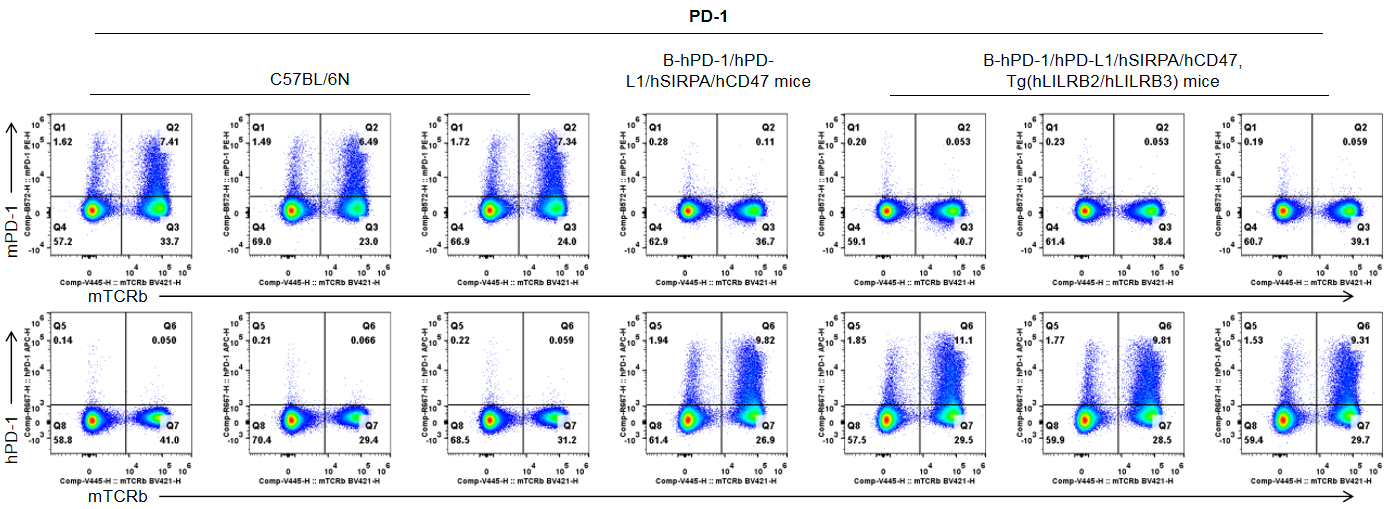
Strain specific PD-1 expression analysis in wild-type mice and B-hPD-1/hPD-L1/hSIRPA/hCD47, Tg(hLILRB2/hLILRB3) mice by flow cytometry. Splenocytes were collected from wild-type C57BL/6N mice, B-hPD-1/hPD-L1/hSIRPA/hCD47 mice and B-hPD-1/hPD-L1/hSIRPA/hCD47, Tg(hLILRB2/hLILRB3) mice (female, n=3, 8-week-old), and analyzed by flow cytometry with anti-mouse PD-1 antibody (Biolegend, 109104) and anti-human PD-1 antibody (Biolegend, 329908). Mouse PD-1 was only detectable in wild-type mice. Human PD-1 was only detectable in B-hPD-1/hPD-L1/hSIRPA/hCD47 mice and B-hPD-1/hPD-L1/hSIRPA/hCD47, Tg(hLILRB2/hLILRB3) mice, but not in wild-type mice.
Protein expression analysis-Spleen T cells-Anti-CD3ε-treated
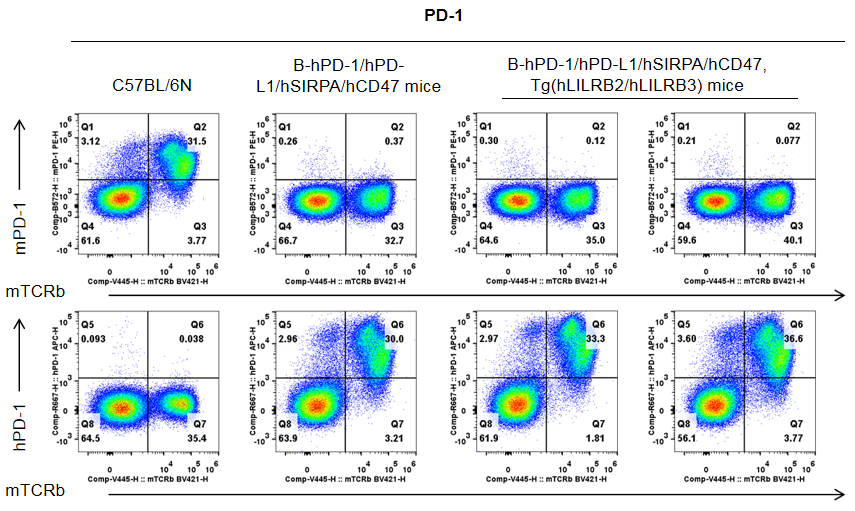
Strain specific PD-1 expression analysis in wild-type mice and B-hPD-1/hPD-L1/hSIRPA/hCD47, Tg(hLILRB2/hLILRB3) mice by flow cytometry. Splenocytes were collected from wild-type C57BL/6N mice, B-hPD-1/hPD-L1/hSIRPA/hCD47 mice and B-hPD-1/hPD-L1/hSIRPA/hCD47, Tg(hLILRB2/hLILRB3) mice stimulated with anti-mouse CD3ε antibody (7.5 μg, i.p.) in vivo for 24 hrs, and analyzed by flow cytometry with anti-mouse PD-1 antibody (Biolegend, 109104) and anti-human PD-1 antibody (Biolegend, 329908). Mouse PD-1 was only detectable in wild-type mice. Human PD-1 was only detectable in B-hPD-1/hPD-L1/hSIRPA/hCD47, Tg(hLILRB2/hLILRB3) mice and B-hPD-1/hPD-L1/hSIRPA/hCD47 mice, but not in wild-type mice.
Protein expression analysis-Spleen T cells
Strain specific PD-L1 expression analysis in wild-type mice and B-hPD-1/hPD-L1/hSIRPA/hCD47, Tg(hLILRB2/hLILRB3) mice by flow cytometry. Splenocytes were collected from wild-type C57BL/6N mice, B-hPD-1/hPD-L1/hSIRPA/hCD47 mice and B-hPD-1/hPD-L1/hSIRPA/hCD47, Tg(hLILRB2/hLILRB3) mice (female, n=3, 8-week-old), and analyzed by flow cytometry with anti-mouse PD-L1 antibody (Biolegend, 124312) and anti-human PD-L1 antibody (Biolegend, 329706). Mouse PD-L1 was only detectable in wild-type mice. Human PD-L1 was only detectable in B-hPD-1/hPD-L1/hSIRPA/hCD47 mice and B-hPD-1/hPD-L1/hSIRPA/hCD47, Tg(hLILRB2/hLILRB3) mice, but not in wild-type mice.
Protein expression analysis-Spleen T cells-Anti-CD3
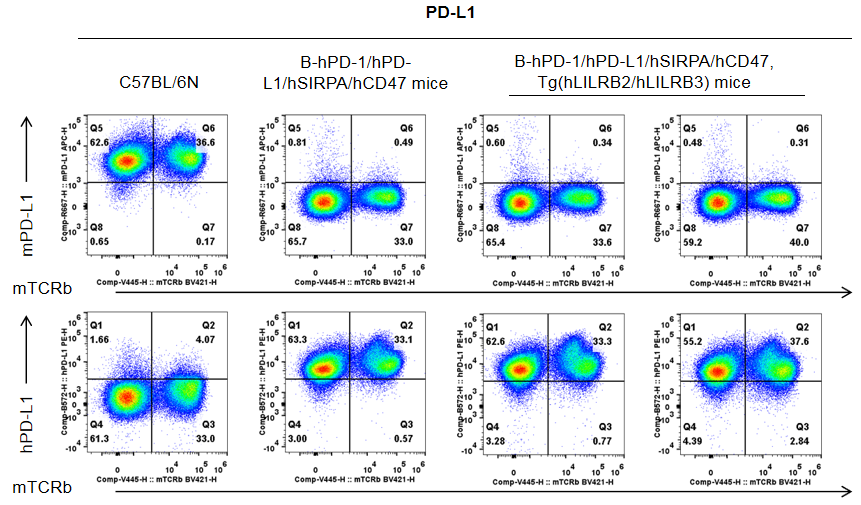
Strain specific PD-L1 expression analysis in wild-type mice and B-hPD-1/hPD-L1/hSIRPA/hCD47, Tg(hLILRB2/hLILRB3) mice by flow cytometry. Splenocytes were collected from wild-type C57BL/6N mice, B-hPD-1/hPD-L1/hSIRPA/hCD47 mice and B-hPD-1/hPD-L1/hSIRPA/hCD47, Tg(hLILRB2/hLILRB3) mice stimulated with anti-mouse CD3ε antibody (7.5 μg, i.p.) in vivo for 24 hrs, and analyzed by flow cytometry with anti-mouse PD-L1 antibody (Biolegend, 124312) and anti-human PD-L1 antibody (Biolegend, 329706). Mouse PD-L1 was only detectable in wild-type mice. Human PD-L1 was only detectable in B-hPD-1/hPD-L1/hSIRPA/hCD47, Tg(hLILRB2/hLILRB3) mice and B-hPD-1/hPD-L1/hSIRPA/hCD47 mice, but not in wild-type mice.
Protein expression analysis-Spleen T cells
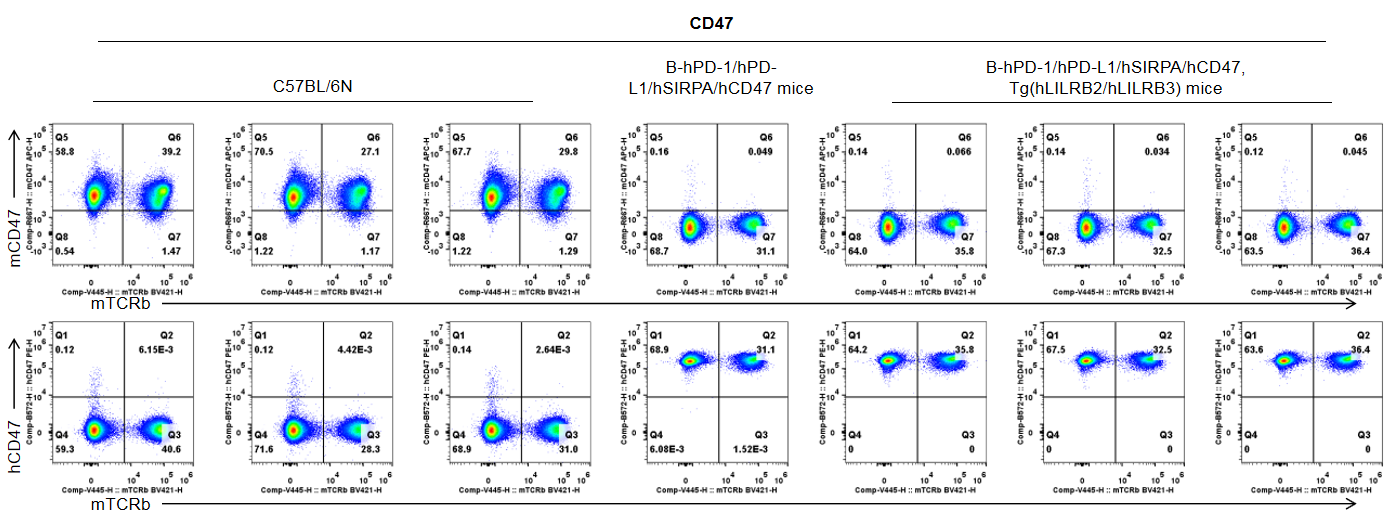
Strain specific CD47 expression analysis in wild-type mice and B-hPD-1/hPD-L1/hSIRPA/hCD47, Tg(hLILRB2/hLILRB3) mice by flow cytometry. Splenocytes were collected from wild-type C57BL/6N mice, B-hPD-1/hPD-L1/hSIRPA/hCD47 mice and B-hPD-1/hPD-L1/hSIRPA/hCD47, Tg(hLILRB2/hLILRB3) mice (female, n=3, 8-week-old), and analyzed by flow cytometry with anti-mouse CD47 antibody (Biolegend, 127514) and anti-human CD47 antibody (Biolegend, 323108). Mouse CD47 was only detectable in wild-type mice. Human CD47 was only detectable in B-hPD-1/hPD-L1/hSIRPA/hCD47 mice and B-hPD-1/hPD-L1/hSIRPA/hCD47, Tg(hLILRB2/hLILRB3) mice, but not in wild-type mice.
Protein expression analysis-Spleen T cells-Anti-CD3
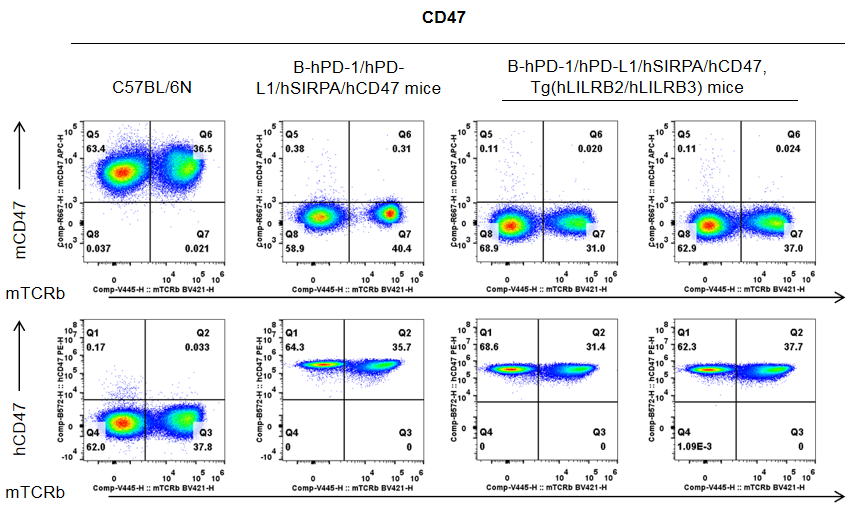
Strain specific CD47 expression analysis in wild-type mice and B-hPD-1/hPD-L1/hSIRPA/hCD47, Tg(hLILRB2/hLILRB3) mice by flow cytometry. Splenocytes were collected from wild-type C57BL/6N mice, B-hPD-1/hPD-L1/hSIRPA/hCD47 mice and B-hPD-1/hPD-L1/hSIRPA/hCD47, Tg(hLILRB2/hLILRB3) mice stimulated with anti-mouse CD3ε antibody (7.5 μg, i.p.) in vivo for 24 hrs, and analyzed by flow cytometry with anti-mouse CD47 antibody (Biolegend, 127514) and anti-human CD47 antibody (Biolegend, 323108). Mouse CD47 was only detectable in wild-type mice. Human CD47 was only detectable in B-hPD-1/hPD-L1/hSIRPA/hCD47, Tg(hLILRB2/hLILRB3) mice and B-hPD-1/hPD-L1/hSIRPA/hCD47 mice, but not in wild-type mice.
Protein expression analysis-RBC
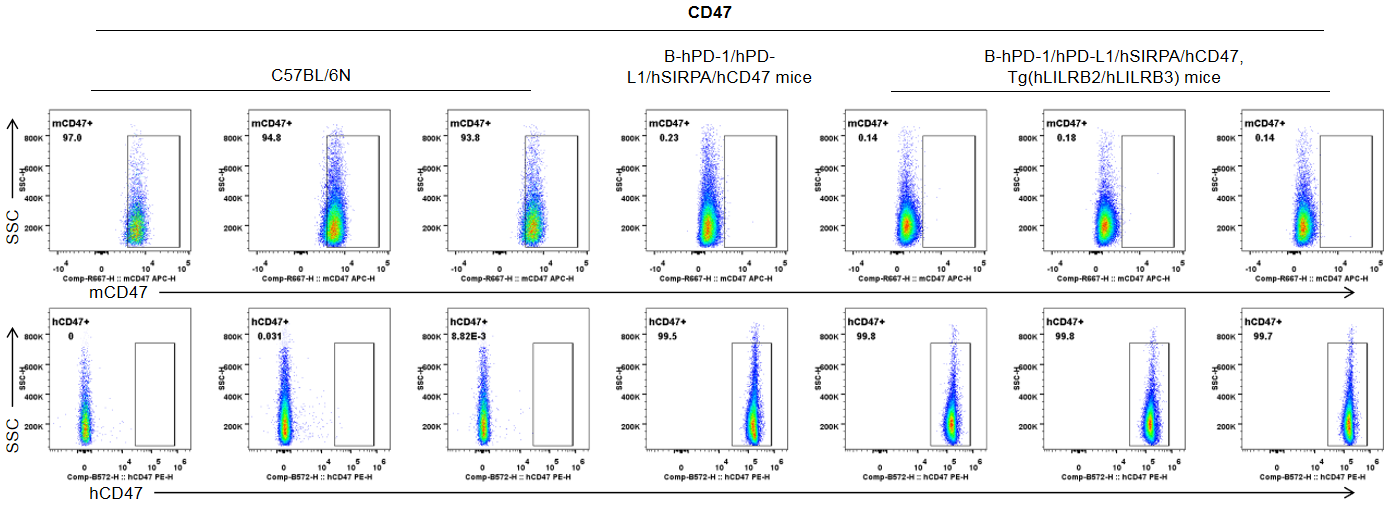
Strain specific CD47 expression analysis in wild-type mice and B-hPD-1/hPD-L1/hSIRPA/hCD47, Tg(hLILRB2/hLILRB3) mice by flow cytometry. Red blood cells were collected from wild-type C57BL/6N mice, B-hPD-1/hPD-L1/hSIRPA/hCD47 mice and B-hPD-1/hPD-L1/hSIRPA/hCD47, Tg(hLILRB2/hLILRB3) mice (female, n=3, 8-week-old), and analyzed by flow cytometry with anti-mouse CD47 antibody (Biolegend, 127514) and anti-human CD47 antibody (Biolegend, 323108). Mouse CD47 was only detectable in wild-type mice. Human CD47 was only detectable in B-hPD-1/hPD-L1/hSIRPA/hCD47, Tg(hLILRB2/hLILRB3) mice and B-hPD-1/hPD-L1/hSIRPA/hCD47 mice, but not in wild-type mice.
Protein expression analysis-Spleen leukocytes
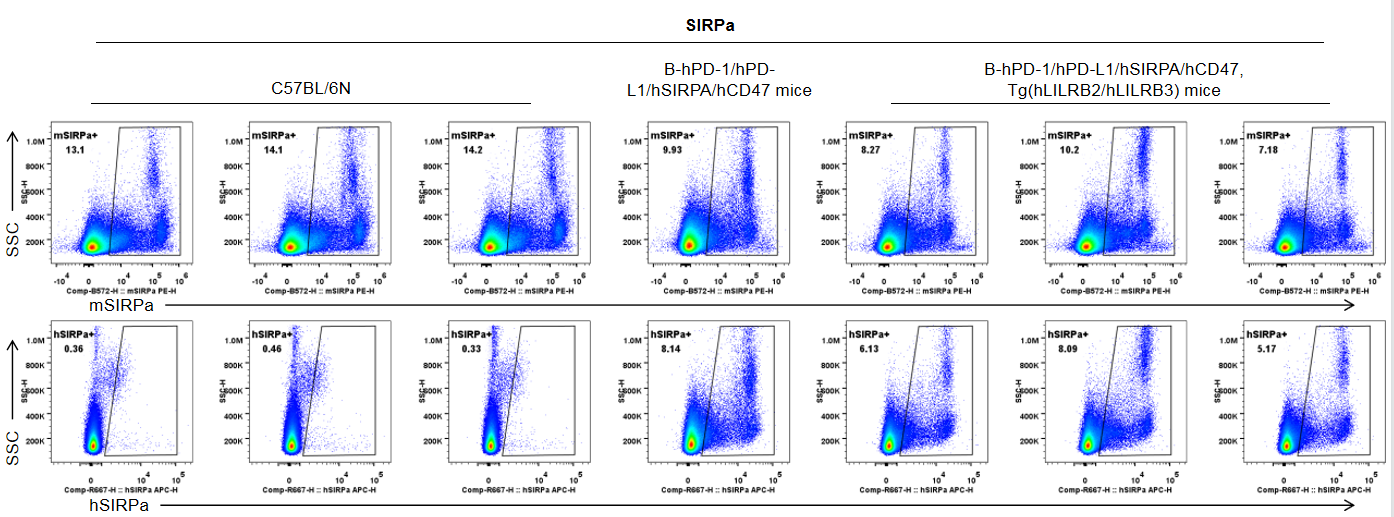
Strain specific SIRPA expression analysis in wild-type mice and B-hPD-1/hPD-L1/hSIRPA/hCD47, Tg(hLILRB2/hLILRB3) mice by flow cytometry. Splenocytes were collected from wild-type C57BL/6N mice, B-hPD-1/hPD-L1/hSIRPA/hCD47 mice and B-hPD-1/hPD-L1/hSIRPA/hCD47, Tg(hLILRB2/hLILRB3) mice (female, n=3, 8-week-old), and analyzed by flow cytometry with cross-recognized both human and mouse SIRPa antibody (Biolegend, 144011) and anti-human SIRPa antibody (Biolegend, 323810). Human SIRPa was only detectable in B-hPD-1/hPD-L1/hSIRPA/hCD47, Tg(hLILRB2/hLILRB3) mice and B-hPD-1/hPD-L1/hSIRPA/hCD47 mice, but not in wild-type mice.
Protein expression analysis-Spleen-T cells
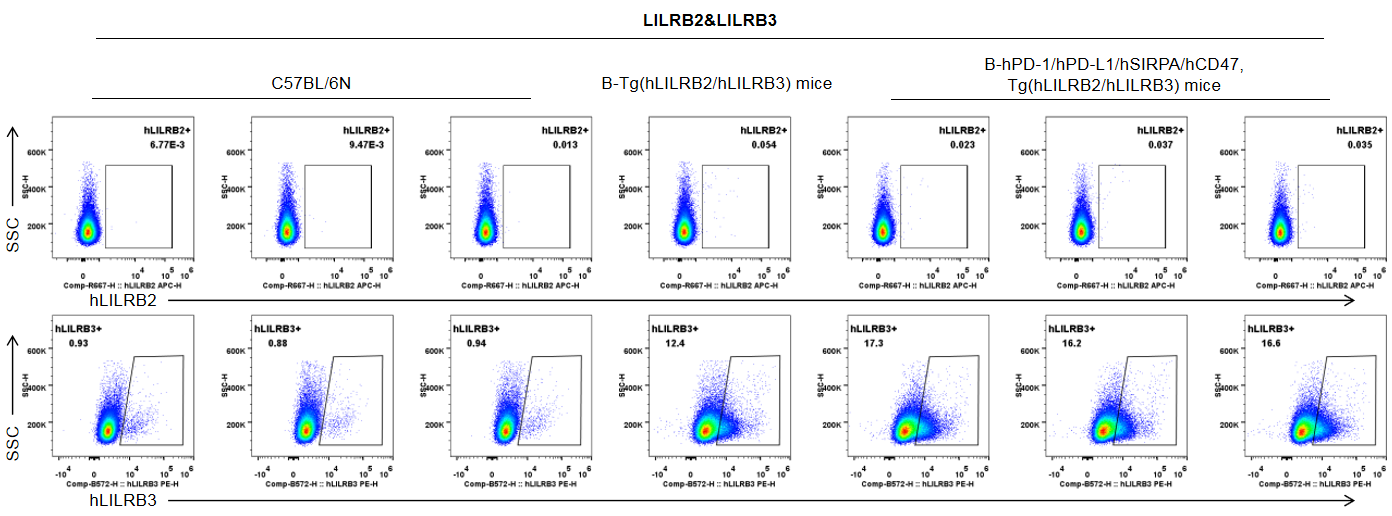
Strain specific LILRB2 and LILRB3 expression analysis in wild-type mice and B-hPD-1/hPD-L1/hSIRPA/hCD47, Tg(hLILRB2/hLILRB3) mice by flow cytometry. Splenocytes were collected from wild-type C57BL/6N mice, B-Tg(hLILRB2/hLILRB3) mice and B-hPD-1/hPD-L1/hSIRPA/hCD47, Tg(hLILRB2/hLILRB3) mice (female, n=3, 8-week-old), and analyzed by flow cytometry with anti-human LILRB2 antibody (Biolegend, 338708) and anti-human LILRB3 antibody (R&D, FAB1806P-100). Human LILRB2 was not detectable in T cells of B-Tg(hLILRB2/hLILRB3) mice and B-hPD-1/hPD-L1/hSIRPA/hCD47, Tg(hLILRB2/hLILRB3) mice. Human LILRB3 was only detectable in T cells of B-Tg(hLILRB2/hLILRB3) mice and B-hPD-1/hPD-L1/hSIRPA/hCD47, Tg(hLILRB2/hLILRB3) mice, but not in wild-type mice.
Protein expression analysis-Spleen-B cells
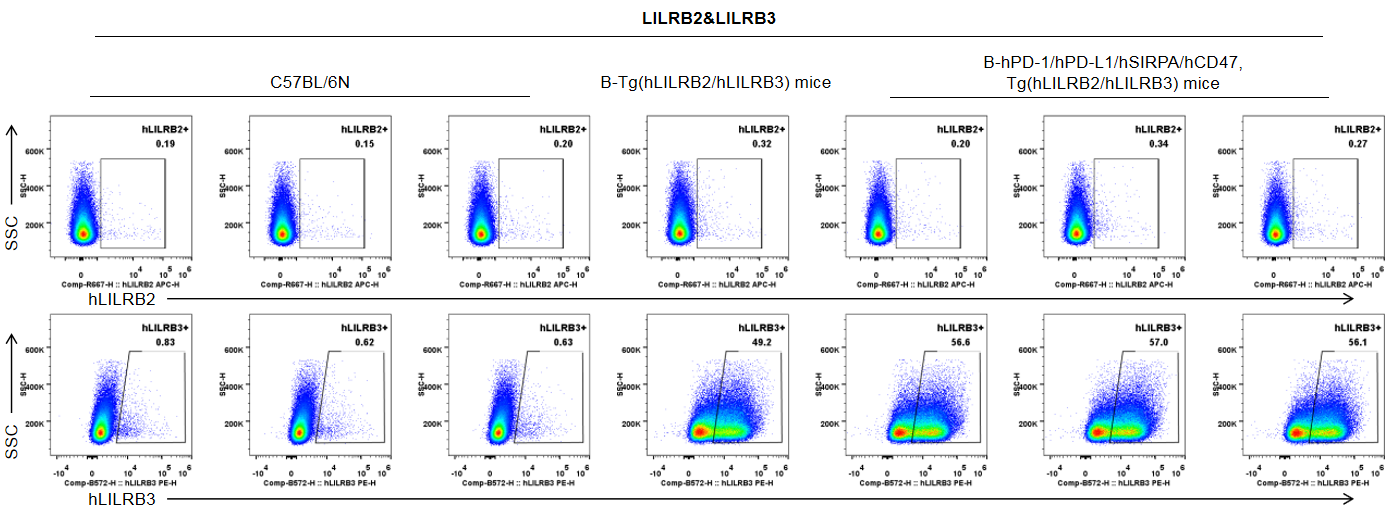
Strain specific LILRB2 and LILRB3 expression analysis in wild-type mice and B-hPD-1/hPD-L1/hSIRPA/hCD47, Tg(hLILRB2/hLILRB3) mice by flow cytometry. Splenocytes were collected from wild-type C57BL/6N mice, B-Tg(hLILRB2/hLILRB3) mice and B-hPD-1/hPD-L1/hSIRPA/hCD47, Tg(hLILRB2/hLILRB3) mice (female, n=3, 8-week-old), and analyzed by flow cytometry with anti-human LILRB2 antibody (Biolegend, 338708) and anti-human LILRB3 antibody (R&D, FAB1806P-100). Human LILRB2 was not detectable in B-Tg(hLILRB2/hLILRB3) mice and B-hPD-1/hPD-L1/hSIRPA/hCD47, Tg(hLILRB2/hLILRB3) mice. Human LILRB3 was only detectable in B cells of B-Tg(hLILRB2/hLILRB3) mice and B-hPD-1/hPD-L1/hSIRPA/hCD47, Tg(hLILRB2/hLILRB3) mice, but not in wild-type mice.
Protein expression analysis-Spleen-Macrophages
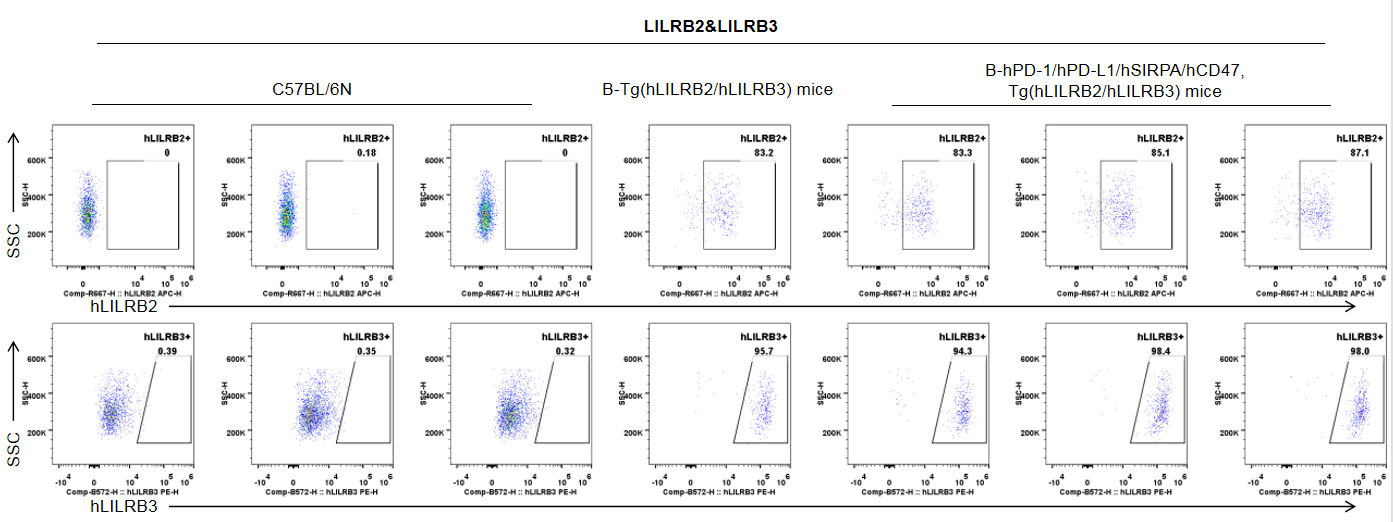
Strain specific LILRB2 and LILRB3 expression analysis in wild-type mice and B-hPD-1/hPD-L1/hSIRPA/hCD47, Tg(hLILRB2/hLILRB3) mice by flow cytometry. Splenocytes were collected from wild-type C57BL/6N mice, B-Tg(hLILRB2/hLILRB3) mice and B-hPD-1/hPD-L1/hSIRPA/hCD47, Tg(hLILRB2/hLILRB3) mice (female, n=3, 8-week-old), and analyzed by flow cytometry with anti-human LILRB2 antibody (Biolegend, 338708) and anti-human LILRB3 antibody (R&D, FAB1806P-100). Human LILRB2 was only detectable in macrophages of B-Tg(hLILRB2/hLILRB3) mice and B-hPD-1/hPD-L1/hSIRPA/hCD47, Tg(hLILRB2/hLILRB3) mice. Human LILRB3 was only detectable in macrophages of B-Tg(hLILRB2/hLILRB3) mice and B-hPD-1/hPD-L1/hSIRPA/hCD47, Tg(hLILRB2/hLILRB3) mice, but not in wild-type mice.
Protein expression analysis-Blood-Monocytes
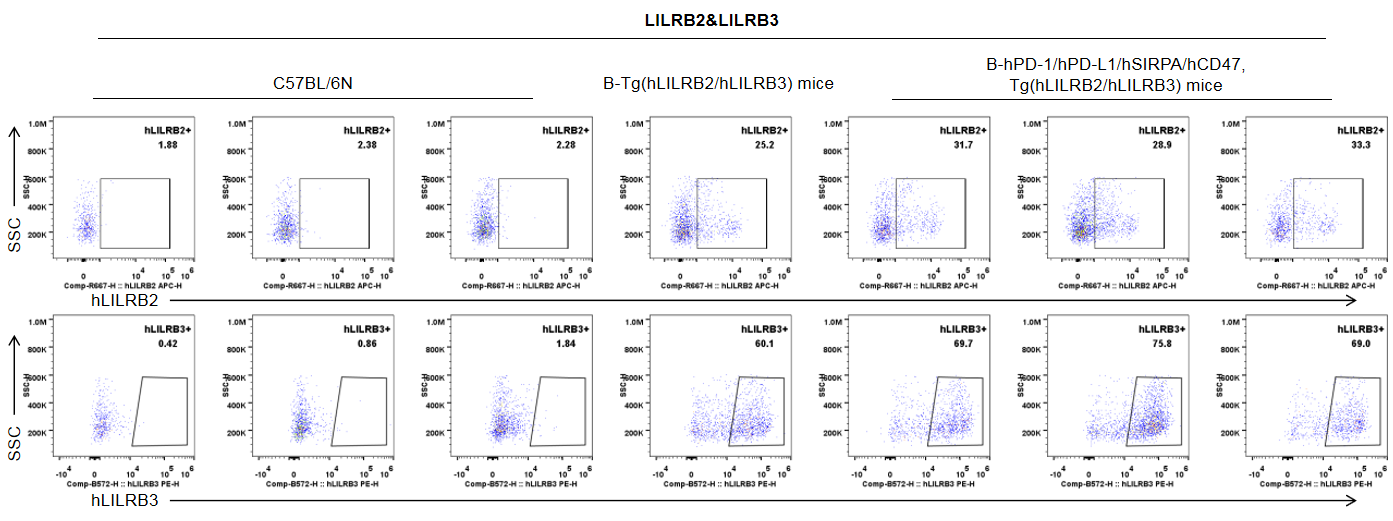
Strain specific LILRB2 and LILRB3 expression analysis in wild-type mice and B-hPD-1/hPD-L1/hSIRPA/hCD47, Tg(hLILRB2/hLILRB3) mice by flow cytometry. Blood cells were collected from wild-type C57BL/6N mice, B-Tg(hLILRB2/hLILRB3) mice and B-hPD-1/hPD-L1/hSIRPA/hCD47, Tg(hLILRB2/hLILRB3) mice (female, n=3, 8-week-old), and analyzed by flow cytometry with anti-human LILRB2 antibody (Biolegend, 338708) and anti-human LILRB3 antibody (R&D, FAB1806P-100). Human LILRB2 was only detectable in monocytes of B-Tg(hLILRB2/hLILRB3) mice and B-hPD-1/hPD-L1/hSIRPA/hCD47, Tg(hLILRB2/hLILRB3) mice. Human LILRB3 was only detectable in monocytes of B-Tg(hLILRB2/hLILRB3) mice and B-hPD-1/hPD-L1/hSIRPA/hCD47, Tg(hLILRB2/hLILRB3) mice, but not in wild-type mice.
Frequency of leukocyte subpopulations in spleen

Frequency of leukocyte subpopulations in spleen by flow cytometry. Splenocytes were isolated from wild-type C57BL/6N mice, B-hPD-1/hPD-L1/hSIRPA/hCD47 mice, B-Tg(hLILRB2/hLILRB3) mice and B-hPD-1/hPD-L1/hSIRPA/hCD47, Tg(hLILRB2/hLILRB3) mice (female, n=3, 8-week-old). A. Flow cytometry analysis of the splenocytes was performed to assess the frequency of leukocyte subpopulations. B. Frequency of T cell subpopulations. Frequencies of T cells, B cells, NK cells, DCs, granulocytes, monocytes, macrophages, CD4+ T cells, CD8a+ T cells and Tregs in B-hPD-1/hPD-L1/hSIRPA/hCD47, Tg(hLILRB2/hLILRB3) mice were similar to those in C57BL/6N mice, demonstrating that humanization of hPD-1, hPD-L1, hSIRPA, hCD47 and the transgene of LILRB2 and LILRB3 do not change the frequency or distribution of these cell types in spleen. Values are expressed as mean ± SEM. The frequency of leukocyte subpopulations in lymph node of B-hPD-1/hPD-L1/hSIRPA/hCD47, Tg(hLILRB2/hLILRB3) mice were also comparable to wild-type C57BL/6N mice (Data not shown).
Tumor growth curve & body weight changes
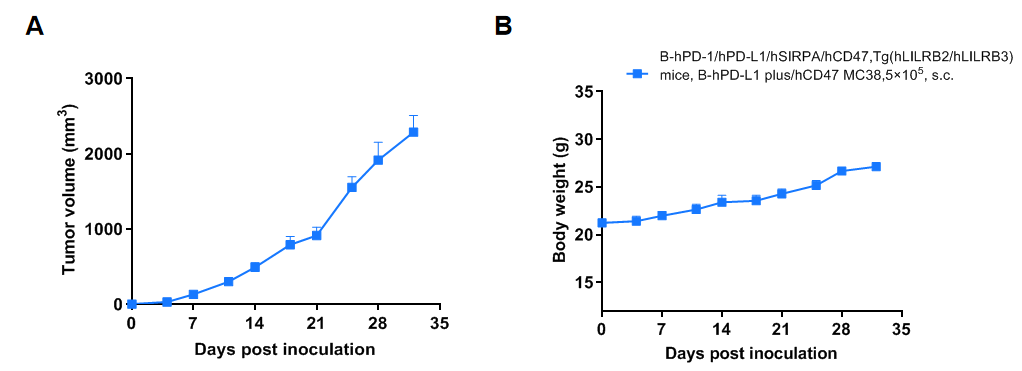
Subcutaneous homograft tumor growth of B-hPD-L1 plus/hCD47 MC38 cells. B-hPD-L1 plus/hCD47 MC38 cells (5×105) were subcutaneously implanted into B-hPD-1/hPD-L1/hSIRPA/hCD47,Tg(hLILRB2/hLILRB3) mice (female, n=6). Tumor volume and body weight were measured twice a week. (A) Average tumor volume ± SEM. (B) Body weight (Mean± SEM). Volume was expressed in mm3 using the formula: V=0.5 × long diameter × short diameter2. As shown in panel A, B-hPD-L1 plus/hCD47 MC38 cells were able to establish tumors in vivo and can be used for efficacy studies.


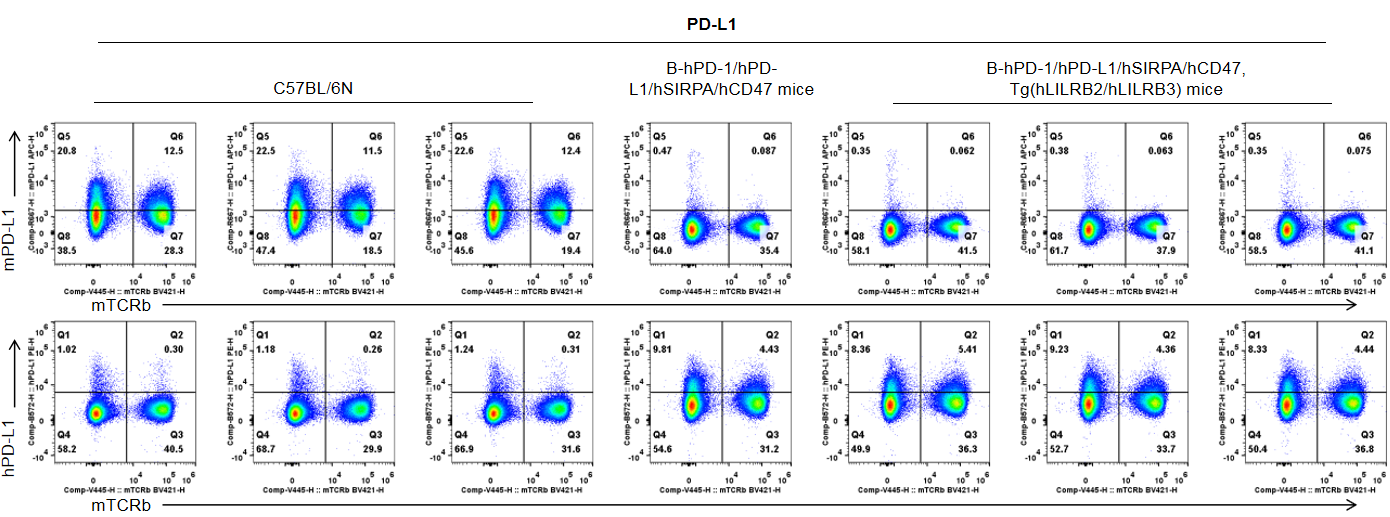























 京公网安备:
京公网安备: